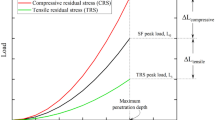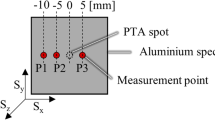Abstract
With the aerospace and aviation industry development, machining deformation is the most prominent and urgent problem in the production process. Studies have shown that initial residual stress (RS) is the main factor causing the deformation of this type of part. Since residual stresses must be analyzed quantitatively, a series of measurement methods have been developed for this purpose. Remarkably, a series of measurement technologies inevitably need to include the corresponding calibration process, which is the fundamental element to ensure RS measurement accuracy. In this investigation, we developed a non-contact stress calibration method based on deflection value to study the measurement deviation of forging residual stress in the aerospace field. The constant stress beam (CSB) mechanical and finite element models of Ti6Al4V titanium alloy were established. The deflection measurement method was implemented using the visual system based on pattern speckle technology. A high precision loading device was developed to provide an accurate external load for CSB. A novel calibration technology based on the deflection method was proposed to realize RS measurement’s calibration process. We have successfully applied the CSB bending test campaigns and deflection metrology method to calibrate the stress values measured by the Static strain measuring instrument of Sigma and the Stress measuring instrument of Proto-ixrd. The results of theoretical and simulation stress are highly consistent with the calibration experiment. Calibration experiments combining the pattern speckle technology and the deflection method allow the stress measurement process’s calibration according to the correction factor. The research provides a great impetus to the development of precise quantitative measurement of RS.





















Similar content being viewed by others
References
Huang L, Kinnell P, Shipway PH (2015) Removal of heat-formed coating from a titanium alloy using high pressure waterjet: influence of machining parameters on surface texture and BHD stress. J MATER PROCESS TECH 223:129–138
Jcw A, Eas B (2003) Progress in structural materials for aerospace systems. Acta Mater 51(19):5775–5799
Michael B, Prime, et al. (2002) Residual stress, stress relief, and inhomogeneity in aluminum plate. SCRIPTA MATER
Gao H, Zhang Y, Wu Q, et al. (2017) influence of initial residual stress distribution on machining deformation of plate blank
Rossini NS, Dassisti M, Benyounis KY et al (2012) Methods of measuring residual stresses in components. MATER DESIGN 35(119):572–588
Guo J, Fu H, Pan B, et al (2019) Recent Progress of Residual Stress Measurement Methods: A Review. CHINESE J AERONAUT
Stone HJ, Withers PJ, Roberts SM, et al (1999) Comparison of three different techniques for measuring the residual stresses in an electron beam-welded plate of WASPALOY. Metallurgical & Materials Transactions
Fontanari V, Frendo F, Bortolamedi T et al (2005) Comparison of the hole-drilling and X-ray diffraction methods for measuring the residual stresses in shot-peened aluminum alloys. J STRAIN ANAL ENG 40(2):199–209
Robinson JS, Hossain S, Truman CE et al (2010) Residual stress in 7449 aluminum alloy forgings. Materials Science & Engineering A 527(10–11):2603–2612
Price JWH, Ziara-Paradowska A, Joshi S et al (2008) Comparison of experimental and theoretical residual stresses in welds: the issue of gauge volume. International Journal of Mechanical Ences 50(3):513–521
Wentao S, Chunguang XU, Qinxue P, et al (2016) Nondestructive Testing and Characterization of Residual Stress Field Using an Ultrasonic Method. Chinese Journal of Mechanical Engineering
Moussaoui K, Segonds S, Rubio W et al (2016) Studying the measurement by X-ray diffraction of residual stresses in Ti6Al4V titanium alloy. Materials Science & Engineering A 667(Jun. 14):340–348
Lu X, Lin X, Chiumenti M, et al. (2019) Residual stress and distortion of rectangular and S-shaped Ti-6Al-4V parts by directed energy deposition: modelling and experimental calibration. Additive Manufacturing
Junjie X, Dongsheng L, Xiaoqiang L (2015) Modeling and simulation for the stress relaxation behavior of Ti-6Al-4V at medium temperature. Rare Metal Materials & Engineering 44(5):1046–1051
Sun Y, Jiang F, Zhang H et al (2016) Residual stress relief in Al–Zn–mg–cu alloy by a new multistage interrupted artificial aging treatment. MATER DESIGN 92(Feb.):281–287
Li S, Xie X, Zhuang Y (2018) Research on the calibration technology of an underwater camera based on equivalent focal length. MEASUREMENT 122:275–283
Martins HA, Birk JR, Kelley RB (1981) Camera models based on data from two calibration planes. Computer Graphics and Image Processing 17(2):173–180
Martinez SA, Sathish S, Blodgett MP et al (2003) Residual stress distribution on surface-treated Ti-6Al-4V by X-ray diffraction. Exp Mech 43(2):141–147
Acknowledgments
This research was financially supported by the Key Research and Development Projects of Shaanxi Province (No.2020GY-253), the Natural Science Basic Research Plan in Shaanxi Province of China (No.2020JQ-182), and the Fundamental Research Funds for the Central Universities (No.3102019ZX004).
Author information
Authors and Affiliations
Corresponding author
Ethics declarations
The authors declare that they have no conflict of interest. This chapter does not contain any studies with human participants or animals performed by any of the authors. Informed consent was obtained from all individual participants included in the study.
Additional information
Publisher’s Note
Springer Nature remains neutral with regard to jurisdictional claims in published maps and institutional affiliations.
Rights and permissions
About this article
Cite this article
Lv, N., Hu, Y., Liu, D. et al. Research on a Novel Non-contact Metrology Technology of Stress Measurement Based on Deflection Method. Exp Tech 45, 809–825 (2021). https://doi.org/10.1007/s40799-021-00464-2
Received:
Accepted:
Published:
Issue Date:
DOI: https://doi.org/10.1007/s40799-021-00464-2




